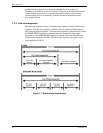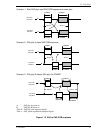
1.3 Phy layer
C141-C013 33
1.3.3 Start conditions of the link reset sequence
Drives start the link reset sequence when they detect any of the following
conditions:
• The power is turned on.
• A loss of signal is detected (OOB from the INIT).
• A loss of sync is detected.
• A HARD_RESET primitive is received during the link reset sequence.
• A hot-plug timeout (500 ms) is detected during the link reset sequence.
• The IDENTIFY address frame could not be received.
1.3.4 Out of band (OOB) signals
Out of band (OOB) signals are low-speed signal patterns detected by the phy that
do not appear in normal data streams. They consist of defined amounts of idle
time followed by defined amounts of burst time. During the idle time, D.C. idle is
transmitted. During the burst time, ALIGN (0) primitives are transmitted
repeatedly. The signals are differentiated by the length of idle time between the
burst times.
Table 1.4 OOB signal timing specifications
Parameter Minimum Nominal Maximum Comments
OOB interval
(OOBI) *1
666,600 ps 666,666 ps 666,733 ps
The time basis for burst times and
idle times used to create OOB
signals. Based on 1,5 Gbps clock
tolerance.
COMSAS detect
timeout
13,65 ìs
− −
The minimum time a receiver shall
allow to detect COMSAS after
transmitting COMSAS.
Derived from: OOBI × 512 × 40
*1 The OOBI is different from the UI (OOB) defined in SATA (for example,
stricter clock tolerance applies to SAS). This is because the OOBI is a
fixed value that is equal to the UI value of G1, and that does not depend on
actual transfer speed used to set up the burst time.
Table 1.5 describes the OOB signal transmitter requirements for the burst time,
idle time, and negation times that comprise each OOB signal.


















